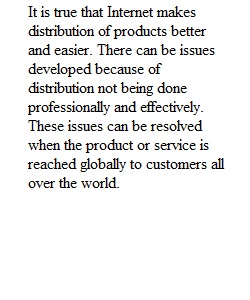


Q Long-tail Theory International trade is crucial for nations to maintain their standard of living, and the global distribution of a wide range of goods. Technological innovations and advances in communications are the engine of growth. The Internet and information technologies (ICT) have facilitated and expedited international business transactions, from delivery to payment (Burinskiene, 2013). Technology and trade are closely interlinked. The world is now going through an era of unprecedented technological change, and a series of innovations that leverage the Internet resulting in a major impact on international trade. For example, artificial intelligence, the Internet of Things, Blockchain, and 3D printing have the potential to profoundly change how we trade, what is traded, and who trades. These changes could unlock several opportunities for businesses, entrepreneurs, and individuals worldwide. However, these developments are not automatic; technological advances alone do guarantee greater trade growth and economic integration. It is the successful management of the structural changes that are driven by technology that is key to ensuring that all stakeholders benefit (WTO, 2018). One of the most significant effects of digital technologies is the extent to which they will reduce trading costs. In addition, digital technologies will affect the composition of trade by (WTO, 2018): 1. Promoting trade in certain goods such as time-sensitive products. 2. Increasing the services component of trade. 3. Changing patterns of comparative advantage and impacting the complexity and length of global value chains. Future technological changes are expected to increase global trade growth, especially in trade in services. Also, and developing countries are expected to gain an increasing share of global trade. And while the expansion of digital trade is likely to result in considerable benefits, international cooperation is needed to “help governments ensure that digital trade continues to be an engine of inclusive economic development” (WTO, 20281, p. 3). Hinz, Eckert, and Skiera (2011) stated that innovations in communication, the Internet, and search engines have dramatically expanded the range of products that online retailers can profitably promote. Anderson (2006) argued that innovations in e-commerce and search engines enhance the efficiency of online retail by encouraging the entry of innovative new products. This results in a long tail of niches, while simultaneously decreasing the market share of blockbuster products. Anderson also argued that Internet innovations reduce the marginal cost of products, allowing online retailers to focus on previously ignored tail products. According to Kendall and Tsui (2011) technological innovations that lower fixed costs relative to variable costs, attract marginal manufacturers which leads to long tails in industries characterized by horizontal differentiation. The Long Tail theory suggests that “as the Internet makes distribution easier — and uses state-of-the-art recommendation systems that allows consumers to become aware of more obscure products — demand will shift from the most popular products at the “head” of a demand curve — as charted on an xy axis — to the aggregate power of a long “tail” made up of demand for many different niche products” (Wharton, 2009, para 3). Evans (2009) stated that online retailers operate in long tail markets where distribution costs are low and inventory may be virtually unlimited. He also argued that advanced search engines, such as Google, Yahoo, and Bing, are “fundamentally Long Tail systems” (p. 9); they have enabled online retailers to sell their niches “all the way down the vanishing point of the tail” (p. 6). Companies such as Alibaba have capitalized on technological advances and huge production potential of China to export products worldwide. These exports range from small retail products to large B2B shipments. Global buyers use Alibaba’s website to shop around for price and variety. References Anderson, C. (2006). The Long Tail: Why the future of business is selling less of more. New York, NY: Hyperion Burinskiene, A. (2013). International trade, innovations and technological achievement in countries. DAAAM International Scientific Book, 795-812. doi:10.2507/daaam.scibook.2013.48 Evans, M. P. (2009). The aggregator blog model: How a blog leverages long tail economics. Journal of Information Science & Technology, 6(2), 3-21. Retrieved from www.jist.info/? Hinz, O., Eckert, J., & Skiera, B. (2011). Drivers of the Long Tail Phenomenon: An empirical analysis. Journal of Management Information Systems, 27(4), 43-69. http://dx.doi.org/doi:10.2753/MIS0742-1222270402 Kendall, T. D., & Tsui, K.B.E. (2011). The economics of the Long Tail. The BE Journal of Economic Analysis & Policy, 11 (1), 1-18. doi: 10.2202/1935-1682.2845 Schuman, M., & Ho, J. (2015). Alibaba and the 40,000 thieves. (cover story). Forbes, 196(7), 100-101. Wharton (2009). Rethinking the Long Tail Theory: How to define ‘hits’ and ‘niches.’ Retrieved from https://knowledge.wharton.upenn.edu/article/rethinking-the-long-tail-theory-how-to-define-hits-and-niches/ WTO (2018). World trade report 2018: The future of world trade. Retrieved from www.wto.org
View Related Questions